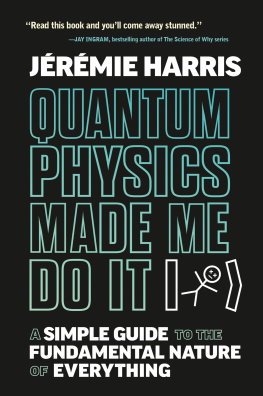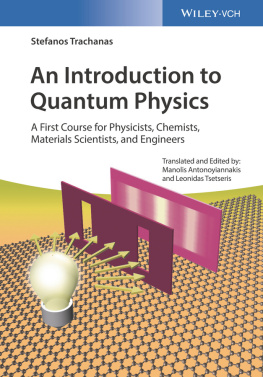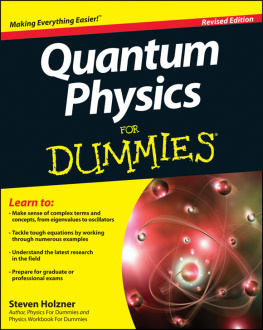Ayden Melton - Quantum Mechanics And Common Sense: Essentials, Theory, and Applications
Here you can read online Ayden Melton - Quantum Mechanics And Common Sense: Essentials, Theory, and Applications full text of the book (entire story) in english for free. Download pdf and epub, get meaning, cover and reviews about this ebook. year: 2022, genre: Computer. Description of the work, (preface) as well as reviews are available. Best literature library LitArk.com created for fans of good reading and offers a wide selection of genres:
Romance novel
Science fiction
Adventure
Detective
Science
History
Home and family
Prose
Art
Politics
Computer
Non-fiction
Religion
Business
Children
Humor
Choose a favorite category and find really read worthwhile books. Enjoy immersion in the world of imagination, feel the emotions of the characters or learn something new for yourself, make an fascinating discovery.
- Book:Quantum Mechanics And Common Sense: Essentials, Theory, and Applications
- Author:
- Genre:
- Year:2022
- Rating:4 / 5
- Favourites:Add to favourites
- Your mark:
- 80
- 1
- 2
- 3
- 4
- 5
Quantum Mechanics And Common Sense: Essentials, Theory, and Applications: summary, description and annotation
We offer to read an annotation, description, summary or preface (depends on what the author of the book "Quantum Mechanics And Common Sense: Essentials, Theory, and Applications" wrote himself). If you haven't found the necessary information about the book — write in the comments, we will try to find it.
Ayden Melton: author's other books
Who wrote Quantum Mechanics And Common Sense: Essentials, Theory, and Applications? Find out the surname, the name of the author of the book and a list of all author's works by series.
Quantum Mechanics And Common Sense: Essentials, Theory, and Applications — read online for free the complete book (whole text) full work
Below is the text of the book, divided by pages. System saving the place of the last page read, allows you to conveniently read the book "Quantum Mechanics And Common Sense: Essentials, Theory, and Applications" online for free, without having to search again every time where you left off. Put a bookmark, and you can go to the page where you finished reading at any time.
Font size:
Interval:
Bookmark:
Essentials, Theory, and Applications
Contents
What I am about to tell is a disconcerting story, which has electrons as protagonists. This is perhaps the most baffling story that has ever emerged in the physical sciences from the seventeenth century onwards. And it is also a true story: all the experiments I will describe were actually performed.
The story develops around two particular physical properties of electrons, which current technology already allows to measure with great precision. We can ignore a rigorous physical definition of these properties, which we will simply call the "color" and "hardness" of the electron.
The property of the electrons that we have called "color" can take on only two values, and this is an empirical fact. We have so far only encountered black electrons or white electrons; we have never found any in blue or green. The same is true for hardness: all electrons are either soft or hard; a different value has never been observed for the hardness of an electron.
It is possible to construct what we will call a "color box", a device for measuring the color of electrons, which works in the following way: the box has three openings (fig. 1), and the electrons are fed through the opening on the left: if the incoming electron is black then it exits (dashed line) from aperture n ("black"); if it is white it comes out of opening b ("white"). The color 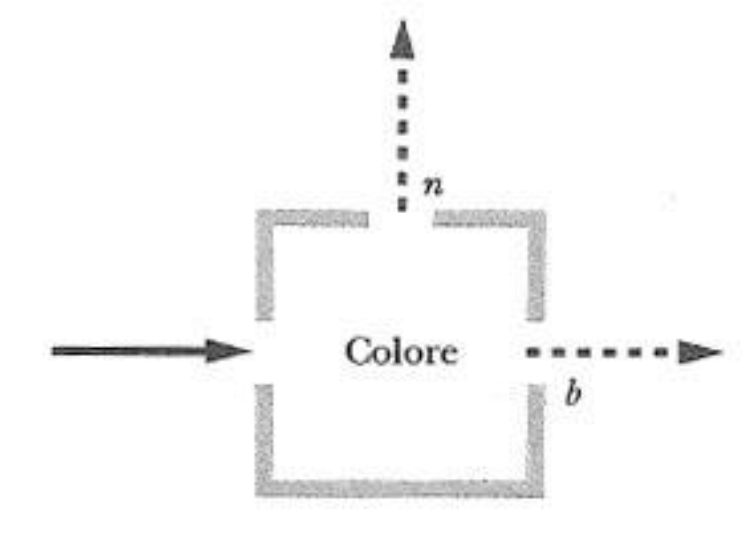 of an entering electron can thus be inferred from its final position. It is also possible to build boxes for hardness, functioning in exactly the same way (fig. 2).
of an entering electron can thus be inferred from its final position. It is also possible to build boxes for hardness, functioning in exactly the same way (fig. 2).
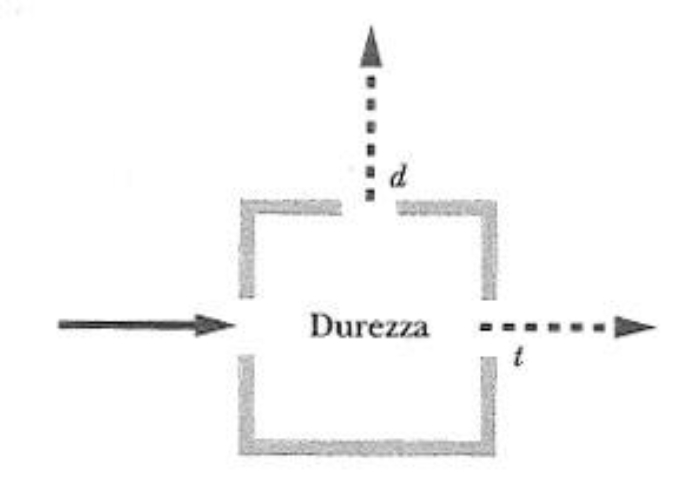 fig. 1
fig. 1
fig. 2
The measurements made with the boxes for hardness and color satisfy, as they are repeatable, a requirement that is now usually imposed by definition on the "acceptable" measurements of any physical quantity worthy of the name. If, for example, a measurement made with a color box shows that a certain electron is black, and if that electron (without having been tampered with) is subsequently fed into the left opening of another color box, it is certain that from the latter it will emerge again through opening no. The same happens with white electrons and, if you use boxes for hardness, with soft ones and with hard ones. All this can be confirmed (and in fact it was) by means of checks carried out with boxes of the two types.
Now suppose we are seized by the desire to know if the color and hardness of the electrons are related to each other. To ascertain this fact, one could check whether correlations exist between the hardness and color values. It is not difficult to carry out such a check with our boxes, from which, on balance, the absence of any correlation emerges. Take a large number of white electrons, for example, and put them in the left opening of the box for hardness: exactly half will emerge from opening d ("hard"), and the other half from opening t ("soft ). The same happens with black electrons, and it is no different with hard (or soft) electrons fed into the left opening of a color box. The color of an electron apparently has no implications whatsoever with respect to its hardness,
Suppose we set up three boxes in succession: one for the color, for example, then one for the hardness and finally another for the color. Let us consider an electron emerging from the white opening of the first box for the color, and therefore (without having been tampered with) is entered into the left opening of the hardness box. From this it emerges, let's say, through the tender opening (as happens to half of these electrons), to be finally introduced (once again without tampering) into the opening on the left of the second box for the color. By the time it enters the latter box, it is presumed that this electron is white and soft. Since there was no tampering with the transition from one box to another, we would expect the electron to emerge from the third box through the white opening, confirming the result of the first measurement. In reality this is not the case, because exactly half of the electrons that followed this path emerge from the white aperture, while the other half (i.e., half of the electrons resulting white and soft according to the measurements made with the first two boxes) emerge from the black opening. The situation does not change if the first two boxes provide a different pair of results, nor if the boxes for color are replaced by boxes for hardness, and the box for hardness is replaced with one for color. Apparently (in the example considered) the presence of the hardness box between the two color boxes constitutes in itself some tampering with the color. In fact, it must be precisely because of the hardness box that half of the white electrons turn into black electrons, since two color measurements, as we already know,
What if the hardness box was badly constructed, in a completely rudimentary way? This box apparently does the job of measuring hardness properly (without changing that property in the process), but in doing so it actually appears to perturb the color. Two questions arise. The first is whether it is possible to build less rudimentary hardness boxes; if the task of measuring hardness can be accomplished in a more refined way, leaving the color unchanged. The second concerns the apparatus considered "rudimentary" and which changes the color of half the electrons of which it measures the hardness: what exactly determines which electrons change color and which do not?
Let's start with the second point. To establish exactly what determines which electrons change color as they pass through the intermediate box for hardness, and which do not, we would probably have to do the following. First of all, all the measurable properties of all the electrons that are placed in the first box for the color during a particular experiment must be kept under strict control and which at that point are, for example, white; it is also necessary to ensure that the physical state of the three boxes remains strictly unchanged for the entire duration of the experiment; and finally it is necessary to look for possible correlations between the measurable physical properties of the incoming electrons and their final positions at the exit from the second box for the color. Well, as far as it has been possible to determine, there is no such correlation. In fact, the data relating to the final results would remain exactly as indicated, no matter how hard we tried, on the one hand to ensure that all the electrons involved in a particular experiment are fed into the first box for the color with identical sets of physical properties, and from the another to ensure that the physical state of the three boxes remains strictly unchanged for the duration of the experiment. The second question, therefore, admits no answer: as far as we have been able to determine so far, there is nothing, absolutely nothing that initially differentiates electrons that change color when passing through a box due to hardness from those that do not. the data relating to the final results would remain exactly as indicated, no matter how hard we tried, on the one hand to ensure that all the electrons involved in a particular experiment are fed into the first box for the color with identical sets of physical properties, and on the other hand to ensure that the physical state of the three boxes remains strictly unchanged for the duration of the experiment. The second question, therefore, admits no answer: as far as we have been able to determine so far, there is nothing, absolutely nothing that initially differentiates electrons that change color when passing through a box due to hardness from those that do not. the data relating to the final results would remain exactly as indicated, no matter how hard we tried, on the one hand to ensure that all the electrons involved in a particular experiment are fed into the first box for the color with identical sets of physical properties, and on the other hand to ensure that the physical state of the three boxes remains strictly unchanged for the duration of the experiment. The second question, therefore, admits no answer: as far as we have been able to determine so far, there is nothing, absolutely nothing that initially differentiates electrons that change color when passing through a box due to hardness from those that do not. on the one hand to ensure that all electrons involved in a particular experiment are fed into the first box for color with identical sets of physical properties, and on the other hand to ensure that the physical state of the three boxes remains strictly unchanged for the duration of the 'experiment. The second question, therefore, admits no answer: as far as we have been able to determine so far, there is nothing, absolutely nothing that initially differentiates electrons that change color when passing through a box due to hardness from those that do not. on the one hand to ensure that all electrons involved in a particular experiment are fed into the first box for color with identical sets of physical properties, and on the other hand to ensure that the physical state of the three boxes remains strictly unchanged for the duration of the 'experiment. The second question, therefore, admits no answer: as far as we have been able to determine so far, there is nothing, absolutely nothing that initially differentiates electrons that change color when passing through a box due to hardness from those that do not.
Font size:
Interval:
Bookmark:
Similar books «Quantum Mechanics And Common Sense: Essentials, Theory, and Applications»
Look at similar books to Quantum Mechanics And Common Sense: Essentials, Theory, and Applications. We have selected literature similar in name and meaning in the hope of providing readers with more options to find new, interesting, not yet read works.
Discussion, reviews of the book Quantum Mechanics And Common Sense: Essentials, Theory, and Applications and just readers' own opinions. Leave your comments, write what you think about the work, its meaning or the main characters. Specify what exactly you liked and what you didn't like, and why you think so.


